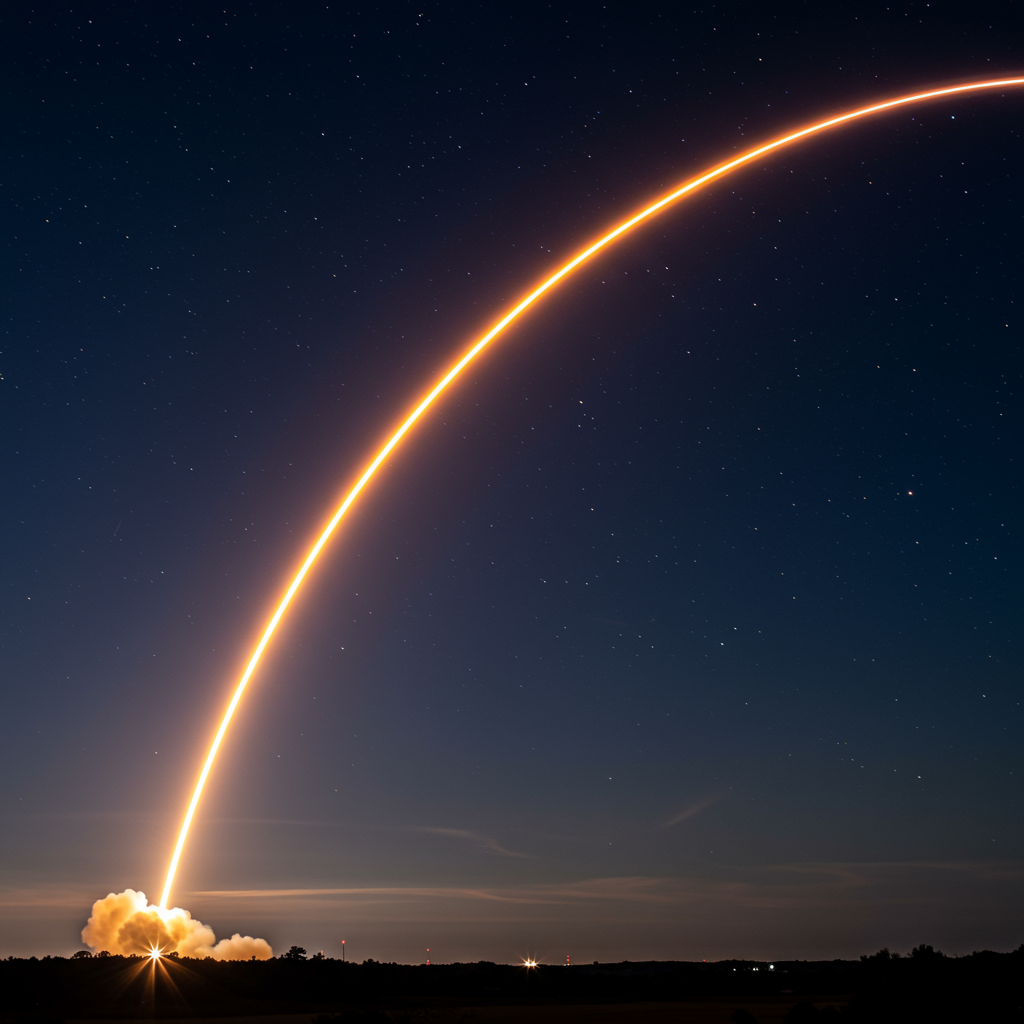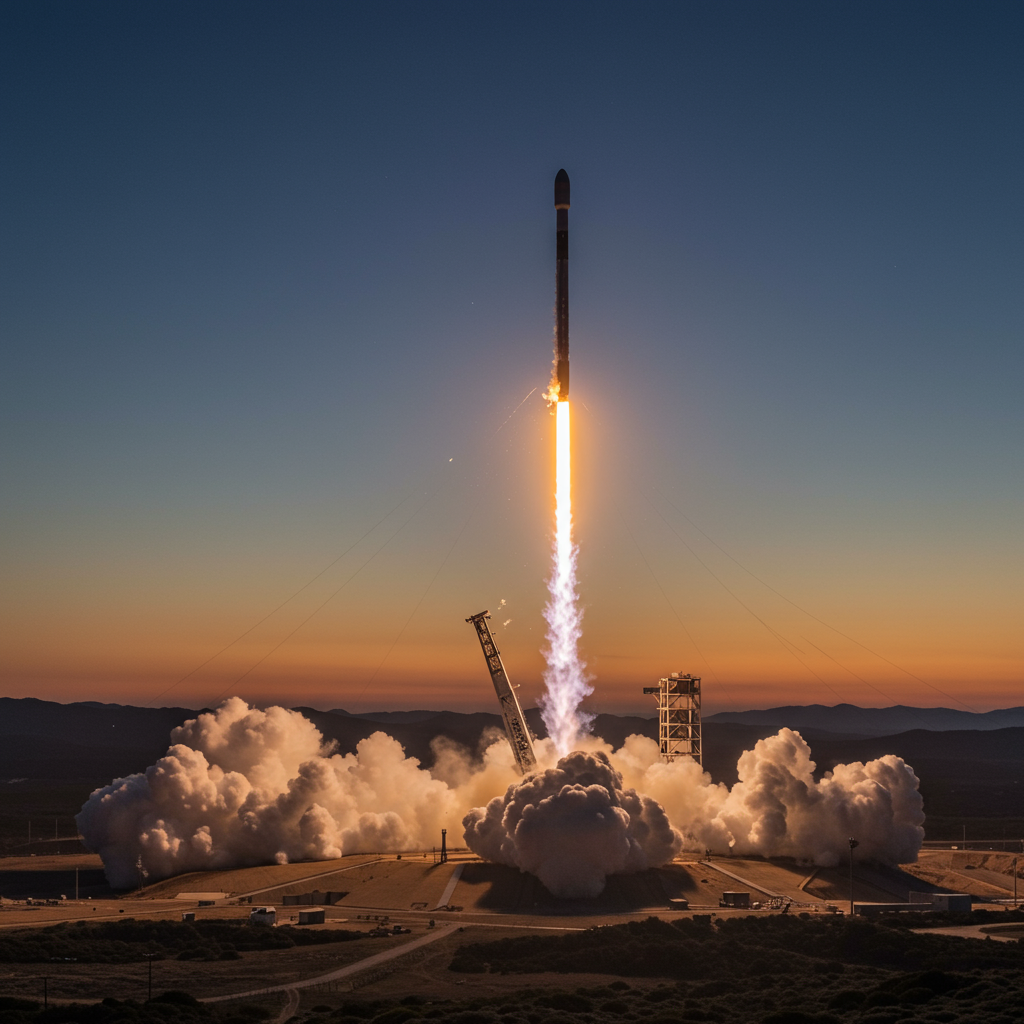Early morning risers across North Carolina recently shared incredible views of a SpaceX Starlink launch, transforming the pre-dawn sky into a luminous canvas. This captivating celestial event, originating from Florida’s Space Coast, illuminated the horizon with a vivid streak, prompting many residents to capture and share their breathtaking photos. If you’ve ever wondered how a rocket launched hundreds of miles away can be so clearly visible, the science behind this atmospheric spectacle is as fascinating as the sight itself.
The Morning Spectacle: SpaceX Starlink Over North Carolina
A recent Saturday morning provided a unique visual treat for North Carolinians, as a SpaceX Starlink mission embarked on its journey to orbit. Shortly after liftoff from Cape Canaveral Space Force Station in Florida, the rocket’s distinctive vapor trail became prominently visible across the state. Numerous reports and photographs poured into newsrooms from various locations, including Garner and parts of Eastern Carolina like Beaufort and Craven counties, confirming widespread sightings.
One striking image, captured by Esai Williams in Garner just before 5:30 AM, showcased a brilliant streak against the still-dark sky. Other viewers, like Hope Tyson from Black Jack and Jeremy Taylor from Ernul/Cayton, also submitted compelling evidence of the phenomenon. These public contributions highlight the profound impact and excitement generated by these increasingly common space endeavors. The sheer distance covered by the visibility — from Florida up the East Coast to North Carolina and even as far as New Jersey — truly underscores the unique conditions that make such displays possible.
Unpacking the Phenomenon: Why Rocket Launches Shine Bright from Afar
The ability to see a rocket launch from hundreds of miles away, particularly at dawn or dusk, is a remarkable interplay of physics and atmospheric conditions. Several key factors converge to create this stunning visibility:
Launch Timing and Trajectory: The SpaceX Starlink launch in question occurred eastward from Florida’s Space Coast. This eastern trajectory is crucial, as it aligns the rocket’s path with the rising sun over the Atlantic Ocean.
Solar Illumination: At the specific time of launch (shortly before 5:30 AM), the sun was just beginning to rise over the horizon. While the ground in North Carolina was still in relative darkness, the rocket quickly ascended into the upper atmosphere, where sunlight was already piercing through.
Earth’s Curvature: As the rocket climbs to extreme altitudes, it rises above the curvature of the Earth. This allows the sun’s rays to directly illuminate the exhaust plumes and vapor trails, even if the sun itself hasn’t yet appeared for observers on the ground. Think of it like a high-flying airplane catching the sun’s light long before sunrise.
Vapor Trails: Rocket engines produce exhaust gases, which, at high altitudes where temperatures are extremely cold, condense to form long, visible vapor trails, similar to contrails from aircraft. When these trails are illuminated by the sun, they become brightly visible against the darker sky below.
This combination of an eastward launch, perfect solar alignment, and the rocket’s high altitude creates an ethereal, glowing effect that can be observed from vast distances. Meteorologists like WRAL’s Chris Michaels have frequently explained that these launches are often most visible during specific windows around sunrise or sunset, when the rocket’s high-altitude exhaust plume can catch the sun’s rays while the ground below remains in twilight.
Beyond Starlink: Other Notable Launches Visible from the East Coast
While Starlink launches are now frequent, other SpaceX missions also provide captivating sky shows. For instance, the historic Polaris Dawn mission, launched on September 10, 2024, from NASA’s Kennedy Space Center, was another prime example of a Falcon 9 rocket’s widespread visibility. This private astronaut mission, which aimed for an unprecedented altitude for a crewed mission since the Apollo era, was seen across multiple states, including North Carolina, Pennsylvania, Massachusetts, and Ohio.
The Polaris Dawn mission, carrying a four-person crew including billionaire Jared Isaacman, demonstrated the capabilities of the Falcon 9 and the Crew Dragon Resilience spacecraft. It was designed to achieve the first-ever commercial spacewalk and orbit Earth at record altitudes, pushing the boundaries of human spaceflight. Such missions highlight the increasing sophistication of commercial space endeavors and the incredible engineering that allows these vehicles to become temporary, brilliant stars in our terrestrial sky. Witnessing these events, whether a Starlink deployment or a crewed mission, offers a direct connection to the forefront of space exploration.
How to Spot the Next Celestial Show
Want to catch a glimpse of the next SpaceX launch from North Carolina? Here are some actionable tips to maximize your chances:
Monitor Launch Schedules: Keep an eye on official SpaceX and space news websites for upcoming launch dates and times from Florida’s Space Coast. Launches typically originate from Cape Canaveral Space Force Station or Kennedy Space Center.
Timing is Key: The best visibility often occurs around sunrise or sunset. For morning launches, look shortly before dawn; for evening launches, look just after dusk. This is when the rocket’s high-altitude exhaust plume is most likely to catch the sun’s rays against a dark or twilight sky.
Look East: Since launches from Florida often travel eastward over the Atlantic Ocean, always face the eastern horizon. The rocket will appear as a small, bright point initially, rapidly growing into a distinct streak.
Patience is a Virtue: The visual phenomenon might not be immediate. Start looking a few minutes after the scheduled launch time and continue observing for up to 30-45 minutes. The vapor trail can linger and evolve as it disperses in the upper atmosphere.
- Check Local Forecasts: Clear skies are essential. Cloud cover will obstruct your view.
- www.wral.com
- www.witn.com
- www.wral.com
- www.space.com
- www.jerseyshoreonline.com
Meteorologists like Chris Michaels often advise local communities about potential visibility windows, making local news sources a valuable resource for advance notice. The collective experience of past sightings, like the vivid display seen on a recent Saturday morning, provides excellent reference points for future observation.
The Growing Era of Space Exploration
SpaceX, through its ambitious Starlink constellation and other missions, is rapidly transforming humanity’s access to space. Starlink aims to provide global internet coverage, particularly in underserved areas, by deploying thousands of satellites into low Earth orbit. Each launch represents another step toward this goal, and the increasing frequency of these missions means more opportunities for stunning sky sightings for those in North Carolina and along the East Coast.
These launches are not just about satellites; they symbolize innovation, scientific advancement, and the persistent human drive to explore. They offer a tangible connection to the cutting edge of aerospace technology, right from our backyards. The public’s enthusiasm, evident in the numerous photos and calls to newsrooms, underscores a shared wonder and fascination with what lies beyond our planet.
Frequently Asked Questions
How can a SpaceX launch be seen so far away from North Carolina?
SpaceX launches from Florida’s Space Coast are visible in North Carolina due to a unique combination of factors. The rocket ascends to very high altitudes above the Earth’s curvature. When the launch occurs around sunrise or sunset, the rocket’s exhaust plume enters direct sunlight while observers on the ground are still in twilight or darkness. This solar illumination causes the vapor trail to glow brightly, making it discernible from hundreds of miles away against the darker sky. The eastward trajectory over the Atlantic also helps align it for visibility along the East Coast.
Where should I look to spot a SpaceX launch from North Carolina?
To spot a SpaceX launch from North Carolina, you should always look towards the eastern horizon. Most launches originate from Cape Canaveral Space Force Station or Kennedy Space Center in Florida and travel eastward over the Atlantic Ocean. The rocket will appear as a bright, ascending streak. It’s best to find an unobstructed view of the eastern sky, away from city lights if possible, and begin watching a few minutes after the scheduled launch time, especially during dawn or dusk windows.
Are all SpaceX Starlink launches visible from North Carolina?
No, not all SpaceX Starlink launches are visible from North Carolina. Visibility depends critically on the time of day and weather conditions. Launches that occur during broad daylight are generally not visible as the sky is too bright for the vapor trail to stand out. The best chances for visibility are during specific “twilight” windows — shortly before sunrise or just after sunset — when the rocket’s high-altitude plume can be illuminated by the sun against a darker sky. Clear skies in both Florida and North Carolina are also essential.
Conclusion
The recent Saturday morning SpaceX Starlink launch provided a memorable spectacle for many across North Carolina, transforming the early sky into a testament to human ingenuity and cosmic wonder. These events, far from being isolated occurrences, are becoming more common as space exploration advances. Understanding the simple science behind their visibility enhances the experience, allowing us to appreciate the delicate balance of light, atmosphere, and orbital mechanics. So, the next time a launch is scheduled from Florida, remember to look up — you might just catch the next breathtaking show unfolding high above the Old North State.




